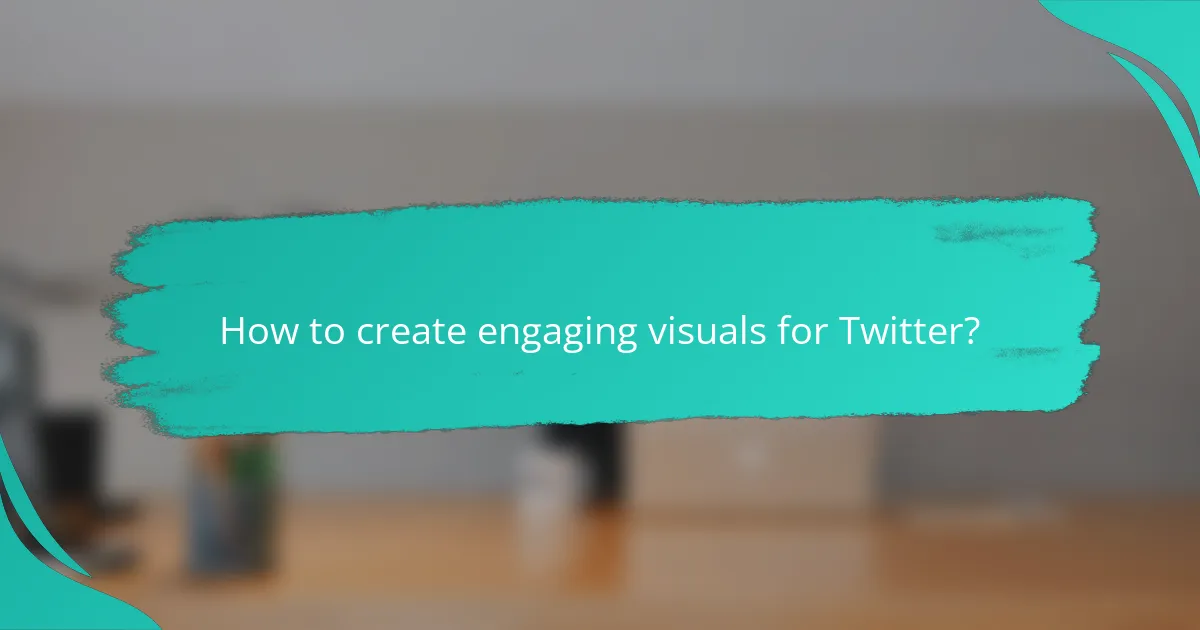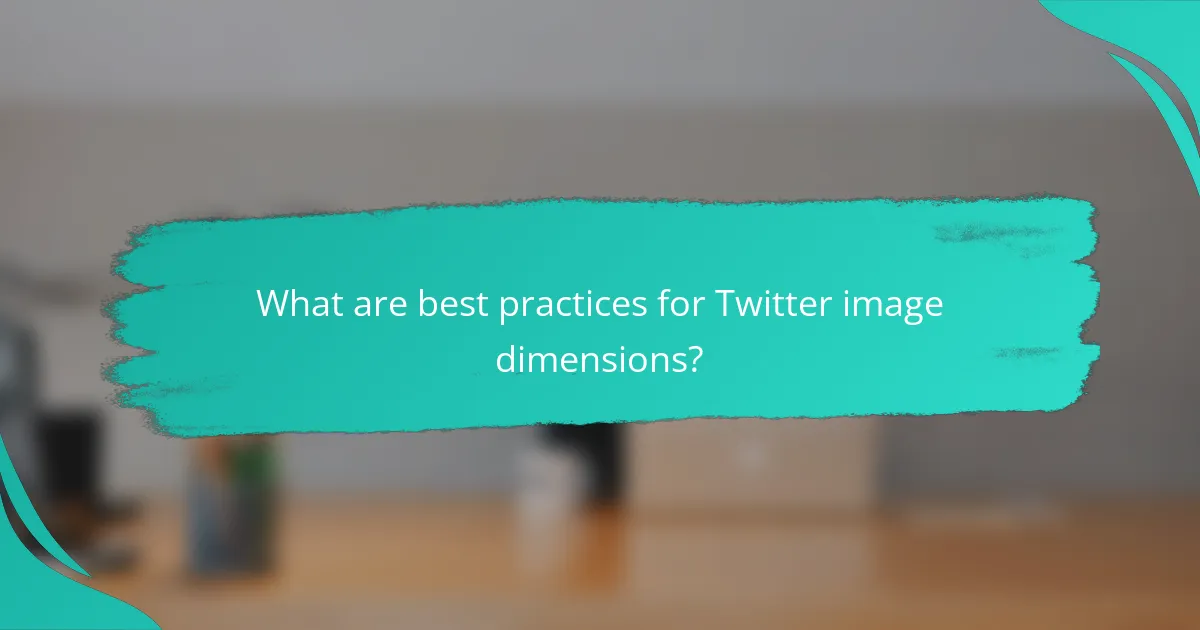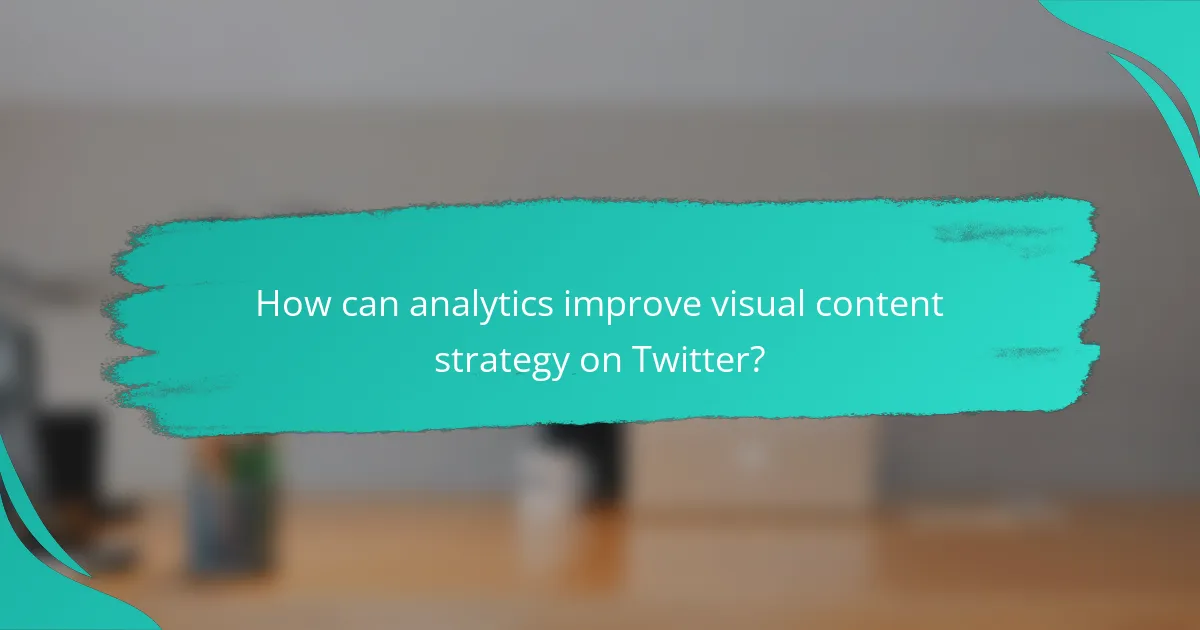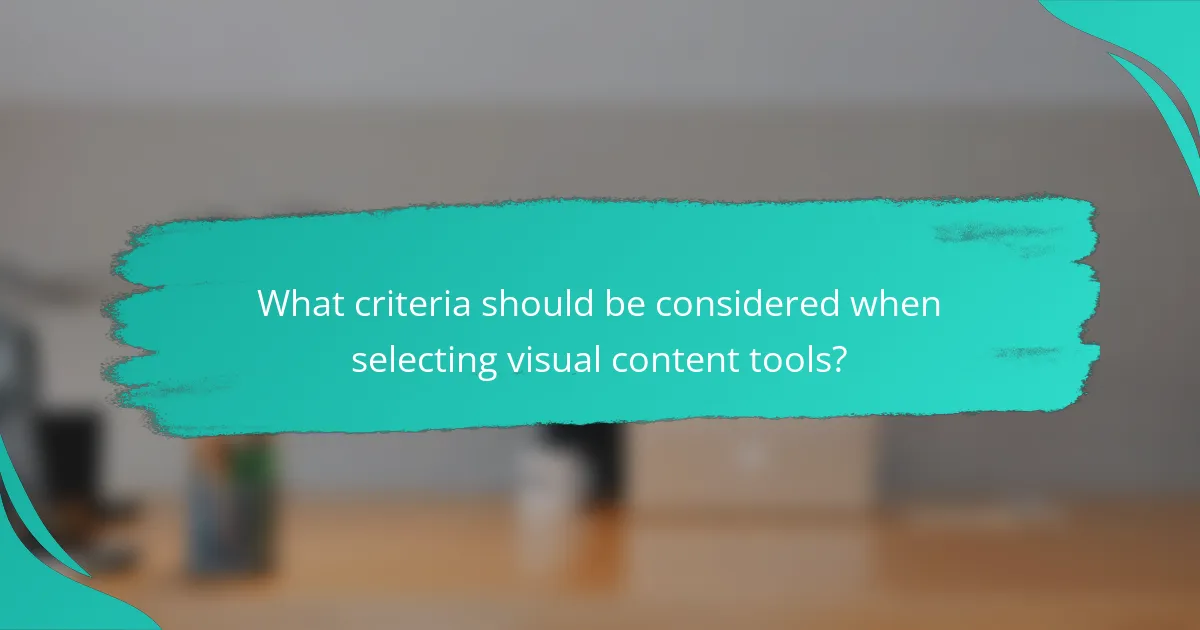Enhancing visual content for Twitter is essential for capturing audience attention and boosting engagement. By utilizing various tools for graphic design and video creation, users can produce eye-catching visuals that align with their branding and messaging. Additionally, adhering to optimal image dimensions ensures clarity and appeal, further encouraging interaction and shares.

What tools enhance visual content for Twitter?
Several tools can significantly enhance visual content for Twitter, making posts more engaging and shareable. These tools cater to various needs, from graphic design to video creation, helping users create eye-catching visuals that resonate with their audience.
Canva for graphic design
Canva is a user-friendly graphic design tool that allows users to create stunning visuals for Twitter without needing extensive design skills. With a wide range of templates, fonts, and images, you can easily customize graphics to fit your brand’s aesthetic.
To get started, select a Twitter post template and modify it with your text, colors, and images. Keep in mind that maintaining brand consistency in colors and fonts can enhance recognition and engagement.
Adobe Spark for video creation
Adobe Spark is an excellent tool for creating short videos that can capture attention on Twitter. It offers templates and easy-to-use features that allow you to combine video clips, images, and text seamlessly.
When using Adobe Spark, aim for videos that are concise, ideally under 30 seconds, to keep viewers engaged. Incorporating subtitles can also help convey your message, especially since many users watch videos without sound.
Piktochart for infographics
Piktochart specializes in creating infographics, which are perfect for sharing complex information in a visually appealing way on Twitter. This tool provides a variety of templates that can help you present data clearly and attractively.
When designing an infographic, focus on clarity and simplicity. Use a limited color palette and clear headings to guide viewers through the information, ensuring that the key points stand out.
Buffer for scheduling visuals
Buffer is a scheduling tool that allows you to plan and post your visual content on Twitter at optimal times. This can help maximize engagement by ensuring your posts reach your audience when they are most active.
To effectively use Buffer, analyze your audience’s activity patterns and schedule posts accordingly. Regularly review performance metrics to adjust your strategy and improve future engagement.
Snappa for quick image editing
Snappa is a straightforward image editing tool that enables quick modifications to visuals, making it ideal for Twitter posts. It offers a variety of templates and stock photos, allowing you to create professional-looking images in minutes.
When using Snappa, focus on creating images that are visually striking yet simple. Avoid cluttering your visuals with too much text or imagery, as this can detract from your main message.

How to create engaging visuals for Twitter?
Creating engaging visuals for Twitter involves using high-quality images, consistent branding, and clear messaging. These elements help capture attention and encourage interaction, making your tweets more effective.
Use high-quality images
High-quality images are essential for grabbing attention on Twitter. Aim for images that are clear, well-composed, and relevant to your content. Avoid pixelated or blurry visuals, as they can detract from your message.
Consider using images with a resolution of at least 1200 x 675 pixels, which is optimal for Twitter. Tools like Unsplash and Pexels offer free high-resolution images that can enhance your posts.
Incorporate brand colors
Incorporating your brand colors into visuals helps create a cohesive identity on Twitter. Use your primary brand colors in graphics, backgrounds, and text to reinforce recognition and trust among your audience.
Limit your palette to two or three colors to avoid overwhelming viewers. Tools like Canva allow you to create templates that consistently use your brand colors across different posts.
Utilize eye-catching typography
Eye-catching typography can make your visuals stand out. Choose fonts that are easy to read and align with your brand’s personality. Avoid overly decorative fonts that may confuse or distract the audience.
Use font sizes that are legible on mobile devices, as many Twitter users access the platform via smartphones. A good rule of thumb is to keep headlines at least 24pt and body text around 14pt.
Include clear calls-to-action
Clear calls-to-action (CTAs) guide your audience on what to do next. Whether it’s visiting a website, retweeting, or participating in a poll, make sure your CTA is straightforward and visually prominent.
Position your CTA within the visual and use contrasting colors to make it stand out. Phrases like “Learn More” or “Join Us” can effectively prompt user interaction and engagement.

What are best practices for Twitter image dimensions?
To maximize engagement on Twitter, adhering to optimal image dimensions is crucial. Properly sized images ensure clarity and visual appeal, enhancing user interaction and content sharing.
Optimal size for shared images
The recommended size for shared images on Twitter is 1200 x 675 pixels. This aspect ratio of 16:9 works well for various types of content, including links and media. Using this size helps maintain image quality and ensures that your visuals appear correctly on different devices.
Avoid using images that are too small, as they may appear pixelated or cropped. Always preview your images before posting to ensure they display as intended.
Recommended size for profile pictures
For profile pictures, Twitter suggests a size of 400 x 400 pixels. This square format allows for clear visibility of your brand or personal image. Ensure that your profile picture is recognizable even at smaller sizes, as it will appear in various contexts across the platform.
Keep in mind that overly complex images may lose detail when scaled down. Simple designs or logos tend to work best for profile images.
Dimensions for header images
The ideal size for header images on Twitter is 1500 x 500 pixels. This wide format allows for a visually striking background that complements your profile. A well-designed header can effectively communicate your brand’s identity or message.
When creating header images, ensure that important elements are centered, as they may be cropped on mobile devices. Test your header across different devices to confirm that it looks good everywhere.

How can analytics improve visual content strategy on Twitter?
Analytics can significantly enhance your visual content strategy on Twitter by providing insights into what resonates with your audience. By tracking performance metrics and audience engagement, you can refine your content to better meet user preferences and increase overall effectiveness.
Track engagement metrics
Tracking engagement metrics is essential for understanding how your visual content performs on Twitter. Key metrics include likes, retweets, replies, and impressions. Regularly monitoring these figures helps identify which types of visuals generate the most interaction.
Use Twitter Analytics or third-party tools to gather data on your posts. Look for trends, such as which images or videos receive the highest engagement rates, and consider adjusting your content strategy accordingly.
Analyze audience preferences
Understanding audience preferences is crucial for creating compelling visual content. Analyze demographic data and engagement patterns to determine what types of visuals appeal to your followers. For instance, younger audiences may prefer dynamic videos, while older demographics might engage more with infographics.
Conduct surveys or polls to gather direct feedback from your audience about their visual content preferences. This information can guide your creative decisions and help you tailor your visuals to better align with audience interests.
Adjust content based on performance
Adjusting your content based on performance analytics is vital for continuous improvement. If certain visuals underperform, consider experimenting with different styles, formats, or messaging. A/B testing can be particularly effective in determining what works best.
Set specific goals for your visual content, such as increasing engagement by a certain percentage over a set period. Regularly review your analytics to assess progress and make informed adjustments to your strategy as needed.

What criteria should be considered when selecting visual content tools?
When selecting visual content tools for Twitter, consider ease of use, integration capabilities, and the specific features that enhance your content creation process. These criteria ensure that you can efficiently produce engaging visuals that resonate with your audience.
Ease of use
Choosing tools that are user-friendly can significantly streamline your visual content creation. Look for platforms with intuitive interfaces that allow for quick edits and adjustments, enabling you to focus on creativity rather than technical hurdles.
Consider tools that offer templates or drag-and-drop functionality, which can save time and reduce the learning curve. Popular options like Canva and Adobe Spark are known for their simplicity and accessibility, making them ideal for users at all skill levels.
Integration with Twitter
Effective visual content tools should seamlessly integrate with Twitter to facilitate easy sharing and posting. Look for features that allow you to publish directly to your Twitter account or optimize images for the platform’s specifications.
Tools such as Buffer and Hootsuite not only help in scheduling posts but also provide analytics to track engagement. This integration can enhance your strategy by ensuring that your visuals reach the right audience at the right time.
